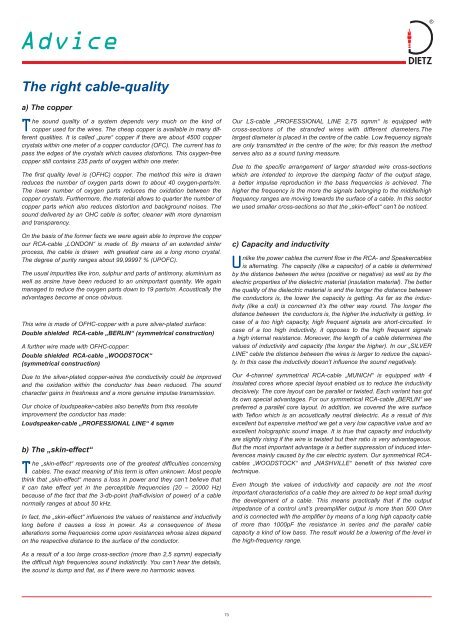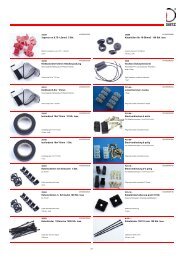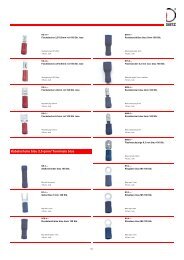Multimedia im Fahrzeug
Multimedia im Fahrzeug
Multimedia im Fahrzeug
Erfolgreiche ePaper selbst erstellen
Machen Sie aus Ihren PDF Publikationen ein blätterbares Flipbook mit unserer einzigartigen Google optimierten e-Paper Software.
Advice<br />
The right cable-quality<br />
a) The copper<br />
he sound quality of a system depends very much on the kind of<br />
Tcopper used for the wires. The cheap copper is available in many different<br />
qualities. It is called „pure“ copper if there are about 4500 copper<br />
crystals within one meter of a copper conductor (OFC). The current has to<br />
pass the edges of the crystals which causes distortions. This oxygen-free<br />
copper still contains 235 parts of oxygen within one meter.<br />
The first quality level is (OFHC) copper. The method this wire is drawn<br />
reduces the number of oxygen parts down to about 40 oxygen-parts/m.<br />
The lower number of oxygen parts reduces the oxidation between the<br />
copper crystals. Furthermore, the material allows to quarter the number of<br />
copper parts which also reduces distortion and background noises. The<br />
sound delivered by an OHC cable is softer, cleaner with more dynamism<br />
and transparency.<br />
On the basis of the former facts we were again able to <strong>im</strong>prove the copper<br />
our RCA-cable „LONDON“ is made of. By means of an extended sinter<br />
process, the cable is drawn with greatest care as a long mono crystal.<br />
The degree of purity ranges about 99,99997 % (UPOFC).<br />
The usual <strong>im</strong>purities like iron, sulphur and parts of ant<strong>im</strong>ony, aluminium as<br />
well as arsine have been reduced to an un<strong>im</strong>portant quantity. We again<br />
managed to reduce the oxygen parts down to 19 parts/m. Acoustically the<br />
advantages become at once obvious.<br />
This wire is made of OFHC-copper with a pure silver-plated surface:<br />
Double shielded RCA-cable „BERLIN“ (symmetrical construction)<br />
A further wire made with OFHC-copper:<br />
Double shielded RCA-cable „WOODSTOCK“<br />
(symmetrical construction)<br />
Due to the silver-plated copper-wires the conductivity could be <strong>im</strong>proved<br />
and the oxidation within the conductor has been reduced. The sound<br />
character gains in freshness and a more genuine <strong>im</strong>pulse transmission.<br />
Our choice of loudspeaker-cables also benefits from this resolute<br />
<strong>im</strong>provement the conductor has made:<br />
Loudspeaker-cable „PROFESSIONAL LINE“ 4 sqmm<br />
b) The „skin-effect“<br />
he „skin-effect“ represents one of the greatest difficulties concerning<br />
Tcables. The exact meaning of this term is often unknown. Most people<br />
think that „skin-effect“ means a loss in power and they can’t believe that<br />
it can take effect yet in the perceptible frequencies (20 – 20000 Hz)<br />
because of the fact that the 3-db-point (half-division of power) of a cable<br />
normally ranges at about 50 kHz.<br />
In fact, the „skin-effect“ influences the values of resistance and inductivity<br />
long before it causes a loss in power. As a consequence of these<br />
alterations some frequencies come upon resistances whose sizes depend<br />
on the respective distance to the surface of the conductor.<br />
As a result of a too large cross-section (more than 2,5 sqmm) especially<br />
the difficult high frequencies sound indistinctly. You can’t hear the details,<br />
the sound is dump and flat, as if there were no harmonic waves.<br />
73<br />
Our LS-cable „PROFESSIONAL LINE 2,75 sqmm“ is equipped with<br />
cross-sections of the stranded wires with different diameters.The<br />
largest diameter is placed in the centre of the cable. Low frequency signals<br />
are only transmitted in the centre of the wire; for this reason the method<br />
serves also as a sound tuning measure.<br />
Due to the specific arrangement of larger stranded wire cross-sections<br />
which are intended to <strong>im</strong>prove the damping factor of the output stage,<br />
a better <strong>im</strong>pulse reproduction in the bass frequencies is achieved. The<br />
higher the frequency is the more the signals belonging to the middle/high<br />
frequency ranges are moving towards the surface of a cable. In this sector<br />
we used smaller cross-sections so that the „skin-effect“ can’t be noticed.<br />
c) Capacity and inductivity<br />
nlike the power cables the current flow in the RCA- and Speakercables<br />
Uis alternating. The capacity (like a capacitor) of a cable is determined<br />
by the distance between the wires (positive or negative) as well as by the<br />
electric properties of the dielectric material (insulation material). The better<br />
the quality of the dielectric material is and the longer the distance between<br />
the conductors is, the lower the capacity is getting. As far as the inductivity<br />
(like a coil) is concerned it’s the other way round. The longer the<br />
distance between the conductors is, the higher the inductivity is getting. In<br />
case of a too high capacity, high frequent signals are short-circuited. In<br />
case of a too high inductivity, it opposes to the high frequent signals<br />
a high internal resistance. Moreover, the length of a cable determines the<br />
values of inductivity and capacity (the longer the higher). In our „SILVER<br />
LINE“ cable the distance between the wires is larger to reduce the capacity.<br />
In this case the inductivity doesn’t influence the sound negatively.<br />
Our 4-channel symmetrical RCA-cable „MUNICH“ is equipped with 4<br />
insulated cores whose special layout enabled us to reduce the inductivity<br />
decisively. The core layout can be parallel or twisted. Each variant has got<br />
its own special advantages. For our symmetrical RCA-cable „BERLIN“ we<br />
preferred a parallel core layout. In addition, we covered the wire surface<br />
with Teflon which is an acoustically neutral dielectric. As a result of this<br />
excellent but expensive method we get a very low capacitive value and an<br />
excellent holographic sound <strong>im</strong>age. It is true that capacity and inductivity<br />
are slightly rising if the wire is twisted but their ratio is very advantageous.<br />
But the most <strong>im</strong>portant advantage is a better suppression of induced interferences<br />
mainly caused by the car electric system. Our symmetrical RCAcables<br />
„WOODSTOCK“ and „NASHVILLE“ benefit of this twisted core<br />
technique.<br />
Even though the values of inductivity and capacity are not the most<br />
<strong>im</strong>portant characteristics of a cable they are a<strong>im</strong>ed to be kept small during<br />
the development of a cable. This means practically that if the output<br />
<strong>im</strong>pedance of a control unit’s preamplifier output is more than 500 Ohm<br />
and is connected with the amplifier by means of a long high capacity cable<br />
of more than 1000pF the resistance in series and the parallel cable<br />
capacity a kind of low bass. The result would be a lowering of the level in<br />
the high-frequency range.<br />
®





